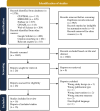Systematic review of exercise for the treatment of pediatric metabolic dysfunction-associated steatotic liver disease
- PMID: 39656734
- PMCID: PMC11630624
- DOI: 10.1371/journal.pone.0314542
Systematic review of exercise for the treatment of pediatric metabolic dysfunction-associated steatotic liver disease
Abstract
Background & aims: Steatotic liver disease affects approximately 1 in 10 children in the U.S. and increases the risk of cirrhosis, diabetes, and cardiovascular disease. Lifestyle modification centered on increased physical activity and dietary improvement is the primary management approach. However, significant gaps in the literature hinder the establishment of exercise as a targeted therapeutic strategy for pediatric metabolic dysfunction-associated steatotic liver disease (MASLD), previously known as nonalcoholic fatty liver disease (NAFLD). We performed a systematic review of studies assessing the impact of exercise interventions on validated hepatic outcomes in children with NAFLD.
Methods: We searched CENTRAL, PubMed, Embase, Web of Science, CINAHL, and Google Scholar on June 5 and 6, 2023, for studies in English involving children aged 0 to 19 years diagnosed with NAFLD or at increased risk for NAFLD due to overweight or obesity. We updated the search on August 8, 2024. Eligible studies were required to examine the impact of exercise interventions on hepatic steatosis or liver chemistry. The risk of bias was assessed with RoB2 and ROBINS-I. Data extraction was performed by two independent reviewers.
Results: After screening 1578 unique records, 16 studies involving 998 children were included. This comprised seven studies comparing exercise intervention with non-exercising controls, three uncontrolled studies of exercise intervention, two studies comparing exercise plus lifestyle interventions with lifestyle interventions alone, and nine studies comparing different types of exercise interventions. Five of the 11 studies that evaluated hepatic steatosis reported an absolute decrease of 1% to 3%. In the nine studies that evaluated liver chemistry, no significant changes were observed.
Conclusions: Evidence supporting exercise intervention for the treatment of pediatric MASLD is limited. Existing studies were constrained by their methodological approaches; thus, there is a pressing need for high-quality future research. This will enable the development of precise, evidence-based exercise guidelines crucial for the effective clinical management of this condition.
Copyright: © 2024 Smith et al. This is an open access article distributed under the terms of the Creative Commons Attribution License, which permits unrestricted use, distribution, and reproduction in any medium, provided the original author and source are credited.
Conflict of interest statement
The authors have declared that no competing interests exist.
Figures




References
-
- Vos MB, Abrams SH, Barlow SE, Caprio S, Daniels SR, Kohli R, et al.. NASPGHAN Clinical Practice Guideline for the Diagnosis and Treatment of Nonalcoholic Fatty Liver Disease in Children: Recommendations from the Expert Committee on NAFLD (ECON) and the North American Society of Pediatric Gastroenterology, Hepatology and Nutrition (NASPGHAN). J Pediatr Gastroenterol Nutr. 2017. Feb;64(2):319–34. doi: 10.1097/MPG.0000000000001482 - DOI - PMC - PubMed

